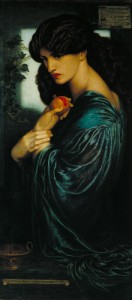People claim there aren’t strong female leads in stories today, or that the strong female leads aren’t perfect because “strong” seems to be their only quality (as if they can’t be otherwise complex characters, too). We haven’t quite solved this problem in modern fiction, but the ancient Greeks got it right. Just look at their mythology. Amazons! Women warriors who took absolutely no flack, killed men for sport, and were all-around badass. Also, goddesses. Athena, for one, was the goddess of war and wisdom and founded the first democracy. And Artemis, goddess of the hunt, maidenhood, and children, was a better archer than Katniss Everdeen could ever hope to be.
Then there’s Persephone. And don’t even think about asking, “Persephone who?” because that is grounds for torment in Tartarus. She’s fabulous, and the Greeks who originally worshipped her respected her character a lot more than some present-day representations do. Such misrepresentation begins with Bernini’s statue, “The Rape of Proserpina,” depicting a frightened young goddess struggling in the burly god of death’s arms. (Notwithstanding, this sculpture is a masterpiece and Bernini is a genius, but it still does my girl Persephone a disservice.) Similarly, in D’Aulaire’s Book of Greek Myths, Persephone is portrayed as a miserable young girl, bitter and silent as she sits by her new husband, Hades.
Other mainstream representations of Persephone follow this trope too, showing her as the jilted, moody, or even cold queen of an unwanted domain (look to Rick Riordan’s Percy Jackson series, which treats Persephone as a mopey part-time resident in the Underworld). To be fair, some renditions of Persephone in modern retellings portray her as less whiny and bitter, like the willful and clear-headed Persephone in Alicia Field’s Love Underground, who chooses to spend time both with Hades and her mother because it’s her choice, not a dictation from Zeus. Other love stories like For the Love of Hades or Seeds portray her as a sweet young goddess thawing the heart of a bitter, brooding god. Better than the moody teenager image, but still not quite what the Greeks had in mind.
There’s no doubt that this myth is fun to play with and fascinates modern audiences. However, the newer adaptations lose quite a bit from the old myth, the so-called “Rape of Persephone.” So let’s talk about the myth quickly. Etymology lesson time: in Latin, the verb “rapere,” (“rap-er-e”) the archaic root of “rape,” just means “snatch” or “steal.” So Persephone wasn’t raped in the sense we would think of today, or at least that kind of rape is not explicitly mentioned. She was simply stolen. It’s a differentiation I want to point out before we all blame Hades for being a creepy rapist. You want creepy rapist? Look to Zeus.
But anyway, the myth of Persephone is only one piece of the puzzle. Yes, Hades did steal Persephone because he thought she was drop-dead gorgeous (pun intended) and wanted her for his bride. And no, I wouldn’t give Hades points for his people skills. (But when you hang out with shades of the dead, do you really have time to practice dating etiquette?) So yes, she gets stolen, yes, Demeter laments her daughter’s disappearance, and yes, Zeus decrees that Persephone must stay in the Underworld one month for each pomegranate seed she ate, but Persephone’s story doesn’t end there. In fact, it only starts there.
In Greek mythology, unlike the adaptations where the love story takes center stage, Persephone’s role as the queen of the Underworld was an integral part of her character. Her epithets in Homer’s Iliad and Odyssey are “dread Persephone,” and “Queen Persephone,” indicating her status and the respect mortals showed her. Furthermore, Hades was not evil, so forget his associations with the Christian devil, and the associations of the Underworld with Hell. In ancient traditions throughout Greece Hades was considered as powerful as Zeus, and aside from his name (which means “unseen”) he was also called Zeus Chthonion, meaning “Zeus under the earth.” By the same token, Persephone was Hera’s equivalent, a queen of a large domain in her own right. Not a whiny, crying teenager by a long shot. And as queen, she had power. Lots of power.
She’s more than just the goddess of spring, although she and her mother, Demeter (goddess of the harvest), are both closely associated with the harvest and agricultural growth. She’s also the goddess of fertility, the blessed dead, and in some instances, the married home. And she is also known to protect women once they reach maturity and marry. At a temple dedicated to her on the island of Locri, Persephone was worshipped alongside Hades as his equal, with her roles of protector, agriculture, and queenliness in tact. It’s not like she was only known for marrying well.
Despite her projected protective and nurturing nature, Persephone is no pushover. She’s the queen of the dead, which includes having a temper and a sense of revenge. I know what you’re thinking: the goddess of spring, vengeful? But it’s true. In ancient myth she was known as the goddess of curses and the mistress (and sometimes mother) of the Erinyes, or Furies, who were demons from the Underworld summoned to seek revenge on earth whenever mortals invoked the Furies’ or Persephone’s names. Their association with Persephone first appears in Aeschylus’s The Libation Bearers She’s also associated with revenge plots; she turned Minthe, a nymph that tried to seduce Hades (rude!), into a mint plant, and she had King Pirithous eternally tortured for trying to steal her from the Underworld. Finally, to further emphasize her coolness, in some traditions she and Hades also preside over the art of necromancy.
While my love of Greek mythology—and mythology in general—is a personal bias, Persephone is a strong, kickass female no matter what, and she should be represented more in modern literature and entertainment. Her story is way more complex than one of a young girl who became a prisoner to the “Greek devil.” So if you want empowered female protagonists who do more than sit around and whine, jump back, WAY back, to the classics. And by that I mean classical classics. The Greeks knew what they were doing, at least regarding epic storytelling. Pun intended.
Featured image via Fir002/Flagstaffotos. “Proserpina” by Dante Gabriel Rossetti via Wiki Commons.



